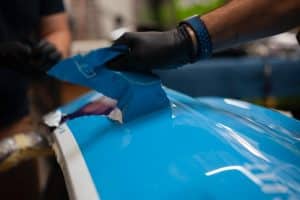How to Protect Your Car’s Paint Job from Sun Damage
 Maintaining a car’s paint job is not just about aesthetics; it also plays a crucial role in protecting the vehicle from sun damage and other environmental threats. Sun damage, in particular, is a common and often overlooked threat that can cause fading, discoloration, oxidation, and peeling. In this article, we will explore the different types of sun damage, the effects of UV rays on car paint, and how to choose the right paint protection to prevent and mitigate these issues.
Maintaining a car’s paint job is not just about aesthetics; it also plays a crucial role in protecting the vehicle from sun damage and other environmental threats. Sun damage, in particular, is a common and often overlooked threat that can cause fading, discoloration, oxidation, and peeling. In this article, we will explore the different types of sun damage, the effects of UV rays on car paint, and how to choose the right paint protection to prevent and mitigate these issues.
Understanding Sun Damage
Sun damage to a car’s paint job can manifest in various ways. Fading and discoloration occur when UV rays break down the pigments in the paint, leading to a dull and washed-out appearance. Oxidation and peeling, on the other hand, result from the weakening of the protective clear coat, causing the paint to chip, crack, or peel off.
UV rays are the main culprit behind sun damage. These rays penetrate the paint’s surface, breaking down the paint molecules and causing them to lose their color and protective properties. Furthermore, prolonged exposure to the sun weakens the clear coat, leaving the paint more vulnerable to damage from other environmental factors.
Choosing the Right Paint Protection
To combat sun damage, it is essential to choose the right paint protection for your car. There are several options available, including waxing and sealants, ceramic coatings, and paint protection film.
Waxing and sealants provide a temporary protective layer that shields the paint from harmful UV rays and other contaminants. They are relatively affordable and easy to apply, but they require regular reapplication to maintain their effectiveness.
Ceramic coatings offer more durable and long-lasting protection. These coatings create a hard, transparent layer that bonds with the paint, providing resistance against UV rays, scratches, and chemical stains. Although they are more expensive and require professional application, ceramic coatings can last for several years with proper maintenance.
Paint protection film, also known as clear bra, is a transparent film that is applied to vulnerable areas of the car’s paint. It provides excellent protection against sun damage, rock chips, and scratches. While it offers the highest level of protection, it can be costly and requires professional installation.
Applying and Maintaining Paint Protection
Applying paint protection requires careful attention to detail. For waxing and sealants, it is important to start with a clean and dry surface. Apply the product using even strokes, allow it to dry, and then buff it to a high shine. Ceramic coatings require thorough surface preparation and decontamination before application. Follow the manufacturer’s instructions for proper application and curing.
Professional installation is highly recommended for paint protection film. A skilled technician will ensure a precise fit and seamless installation. Regular maintenance, such as hand washing and avoiding automated car washes, is crucial for preserving the integrity of the paint protection film.
Additional Measures to Protect Your Car’s Paint Job
In addition to paint protection, there are other measures you can take to minimize sun damage. Parking your car in covered spaces or using car covers and sunshades can significantly reduce sun exposure. Establishing a regular cleaning and maintenance routine, using proper washing and drying techniques, and promptly addressing bird droppings and tree sap can also help prevent damage.
Conclusion
Maintaining your car’s paint job is essential for both its appearance and protection. Sun damage is a common threat that can cause fading, discoloration, and peeling. By understanding the different types of sun damage, choosing the right paint protection, and implementing additional protective measures, you can safeguard your car’s paint job and keep it looking great for years to come. Take a proactive approach to protect your investment and ensure the long-lasting beauty of your vehicle.
